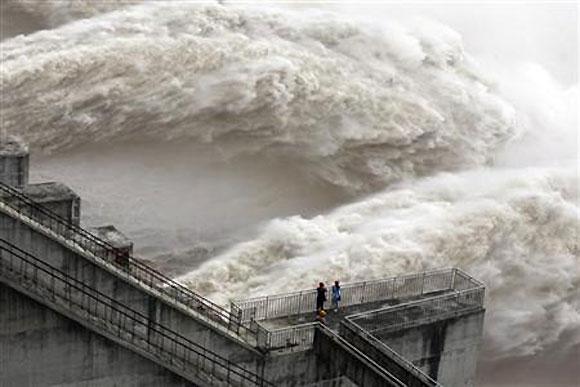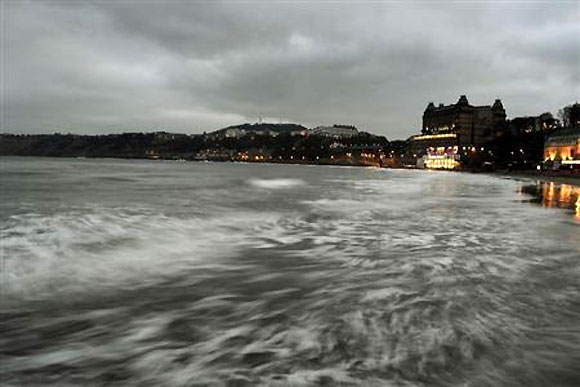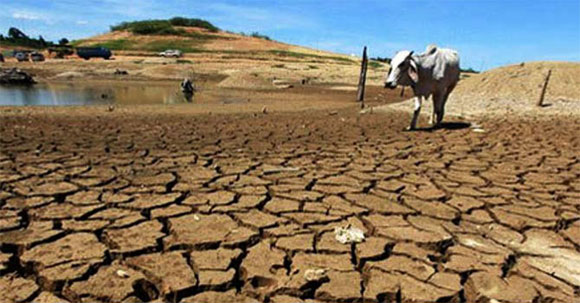Photographs: Reuters Rajni Bakshi
Financial markets and public policy will have to privilege those businesses which not only reduce emissions but try to holistically resuscitate the environment.
It will be some time before the full extent of damage to hydro-projects in Uttarakhand is calculated. Stray reports indicate that equipment and structures of several projects have been washed away or irreversibly damaged.
This is reason enough for business and industry to look more closely at the long term implications of the Uttarakhand tragedy. What if, as environmentalists are warning, this is a sign of things to come?
According to a report released by the World Bank in mid June this year, India’s food security, water resources and health are indeed at risk from global warming.
Evidence of the disruption of the natural monsoon cycle in India has been mounting for some time. For instance, 340 mm fell in a single day in Uttarakhand -- a record not seen for five decades.
One of the features of climate change is that what were once rare catastrophic weather events will become more frequent.
Click on NEXT for more...
Business lessons from Uttarakhand
Photographs: Dylan Martinez/Reuters
The World Bank report titled Turn Down The Heat: Climate Extremes, Regional Impacts and the Case for Resilience – looks at the likely impacts of warming in South Asia, Sub-Saharan Africa, and South East Asia.
It shows that at current rates of emissions a 2°C increase in the world temperature is very likely to happen within the next 20 to 30 years – not at the end of the 21st century as earlier predicted.
This would disrupt weather patterns and result in widespread food and water shortages – caused either by furious floods of the kind seen in Uttarakhand or prolonged droughts accompanied by unprecedented heat-waves.
The good news is that shifts in industrial patterns and lifestyles may yet be able to reduce the extent of warming. For this to be possible both financial markets and public policy will have to privilege those businesses which not only reduce emissions but try to holistically resuscitate the environment.
Click on NEXT for more...
Business lessons from Uttarakhand
Photographs: Reuters
For example, there are enormous business opportunities in developing drought resistant crops, better ground water management techniques, building stronger flood defense, improving energy efficiency and proliferating different forms of renewable energy.
“In a very real sense development is the best adaptation” says the World Bank report “investing in skills, health, knowledge, better infrastructure and a more diversified economy will render countries more climate-resilient.”
It goes on to laud the government of India as having “accorded top priority to the issue of climate change” with action plans on eight crucial sectors.”
This view is not shared by most environmentalists. At present an estimated 680 dams are in various stages of planning, or construction in Uttarakhand. These dams are not being blamed for the cloud-burst that wrecked havoc.
But, according to statement issued by India Climate Justice network, these dams have a direct connection with the extent of the damage that can be caused in case of flash floods.
Click on NEXT for more...
Business lessons from Uttarakhand
Photographs: Pawel Kopczynski/Reuters
The tunneling and excavation in run-of-the-river projects causes huge and unregulated dumping of excavated debris into river basins, leading to increased siltation. This in turn makes areas outside the rivers normal course susceptible to flooding.
In 2009, the Comptroller and Auditor General (CAG) had warned the government of Uttarakhand that the “potential cumulative effect of multiple run-of-the-river projects can turn out to be environmentally damaging”.
But the fundamental issue, according to the Climate Justice statement, is equity: “ The electrical power generated by these dams will be consumed by urban elites elsewhere.
It is ironic that these dam projects, while adversely impacting people’s access to their river commons, claim to be climate change solutions in the guise of renewable and green energy, and have already made huge profits by fraudulently claiming CDM (clean development mechanism) status.”
Click on NEXT for more...
Business lessons from Uttarakhand
Photographs: Henry Romero/Reuters
Some of the solutions favored by Climate Justice advocates are:
That governments, both at Centre and in the States, adopt a low carbon pathway of development that has equity and ecologically sustainable employment at its core.
Planning and construction of dams in the entire Indian Himalayas be reviewed, and all construction halted until such a review is carried out.
That a proper assessment of the carrying capacity of specific ecosystems is carried out.
That the stretch from Gaumukh to Uttarkashi be declared an eco-sensitive zone without further delay.
That a river regulation zone be enforced such that no permanent structures are allowed to be constructed within 100 metres of any river.
Click on NEXT for more...
Business lessons from Uttarakhand
Photographs: Lucy Nicholson/Reuters
It may be time for business and industry to consider these ideas seriously rather than rejecting them as anti-development or anti-growth.
The International Finance Corporation, the World Bank Group’s private sector arm, is financing several Indian companies to build “climate smart solutions”. For example, it is introducing efficient water use technologies for basmati rice cultivation in Haryana.
A program called Lighting Asia – is providing renewable lighting solutions amongst two million people in rural India.
Of course there are some differences between World Bank’s approach to solutions and those put forward by many environmentalists.
The profitable businesses of the future will be those who tap into the knowledge and insights emerging from both these grids -- multi-lateral agencies and civil society groups.
Those who venture into fray without a holistic approach to the realities of climate change may still make short term gains but are unlikely to be the companies of the future.







article